Posted by: Ken @ 6:15 am
We often joke that Florida has two seasons, hot and hotter. We also generally have a dry fall and winter season that gives way to a wet and humid summer. Although our mangoes and avocados put out inconspicuous blossoms, south Florida experiences no explosion of color to mark the onset of the vernal equinox. The mockingbirds sing all year around, though their tempo and volume picks up just as the Palm Warblers depart to breed in far northwestern Canada.
Up north, robins herald the arrival of spring, but we rarely see a robin at any time of the year. For birders looking for warblers, spring migration can be a non-event. If the usual east-west wind pattern persists, it drives northbound birds to the west coast of the Florida peninsula, or they may fly directly from Cuba across the Gulf of Mexico to make landfall.
One bird that can be counted on to arrive at our back yard lake in the middle of April is the Least Tern (Sternula antillarum). While it is the smallest of the tern family at about 9 inches long with a wingspan of 20 inches, it makes up for its small size with graceful energetic flight, strident calls and interesting behaviors. 
There are three distinct populations (subspecies) of Least Terns in the US. One group nests in limited areas on the beaches of western Mexico and California. A second finds sandy places to nest along rivers and streams in the mid-west. Both of these populations are of particular conservation concern. With protection of its nesting areas, the endangered California population has increased from less than 600 pairs in 1974 to over 4500 pairs, while the interior subspecies have increased to 7,000 pairs from a low of 1,000 pairs in 1985 .
Our Florida birds belong to the third subspecies, which breeds up and down the entire US Atlantic coast, wintering in the Caribbean and along the east coast of Central and northern South America. All three populations face threats from human activities, notably destruction of beaches and loss of beach and stream-side habitat. Plume hunters took a huge toll in the late 1800s– I have seen photos of ladies’ dainty hats adorned with the whole bodies of one or more Least Terns. Though not on the Endangered Species list, the U.S. Fish & Wildlife Service lists the east coast Least Terns as a Species of Management Concern.
I bought my Canon 60D camera just a year ago, and my very first practice flight shots were of Least Terns flying past our back patio. This was my first “keeper.”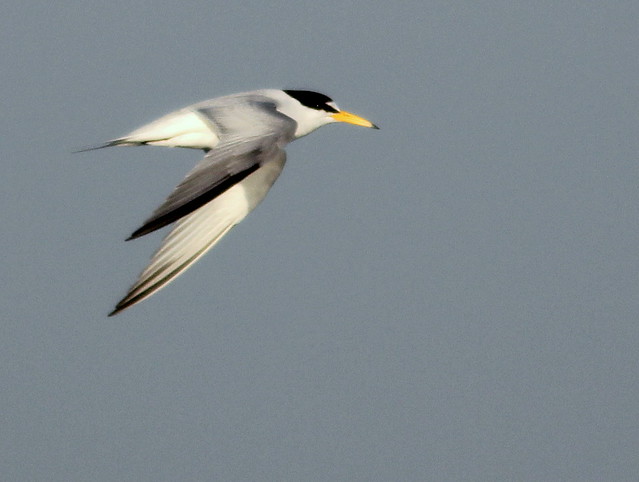
This spring the terns began competing for mates as soon as they arrived. Once bonded, the pair stays loyal to each other for the entire breeding season. The male must prove his prowess as a provider by catching fish and offering it to his intended mate. The male and female plumage is very similar. During breeding season, the males are said to have brighter orange-yellow bills, legs and feet, though this is not very noticeable.
Following the age-old Least Tern courtship ritual, the female waits patiently while her suitor hunts for a small fish. When he catches one, he calls excitedly and flies toward the female’s position, sometimes adding a dramatic flourish by swooping past her. The female eagerly awaits his arrival, calling back and begging.
He then offers her the fish…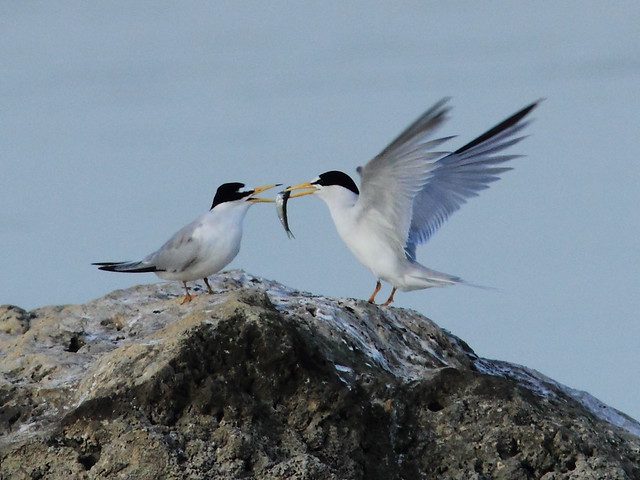
…which she gratefully accepts.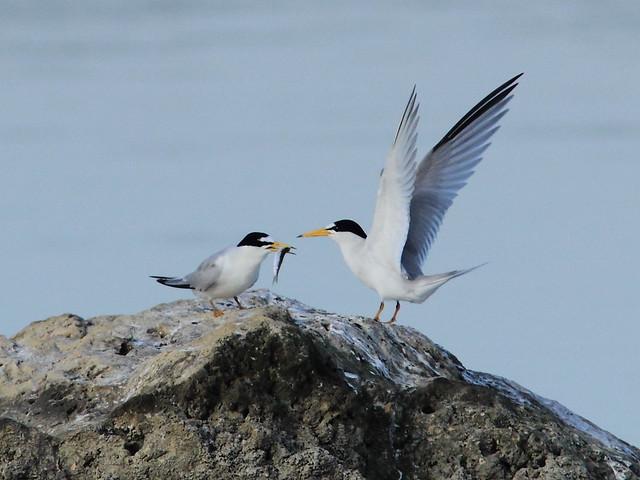
As she eats the fish, the male assumes various postures, usually freezing in place for a few seconds.
Here, after she has swallowed it, he continues to point his bill skyward for a moment.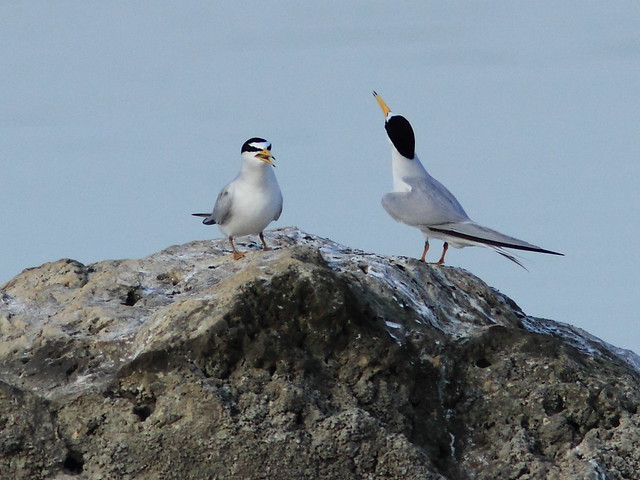
The pair bond is strengthened, and he will repeat the procedure many times. After two or three weeks, if he is accepted, they will mate as he offers a fish. Courtship usually occurs in the foraging area rather than on the nesting grounds.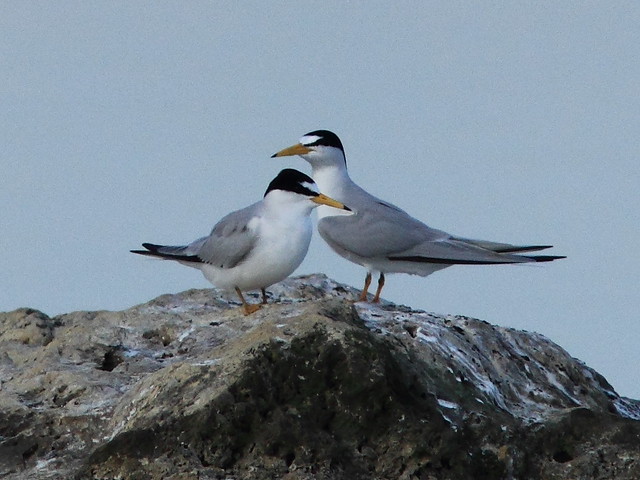
I am quite sure that Least Terns have nested on the gravel roofs of an elementary school and a strip mall in our neighborhood. Young terns are precocious and are able to walk about soon after hatching, but they remain dependent upon their parents until they move south in late summer.
Last summer these two immature terns were being trained to fish by their parents. The adults would catch a fish and make their youngsters chase after them. The adults would then drop the fish in the water and fly down as if to get to it before the “trainees.” If not retrieved, the parents would pick up the fish and try all over again.
Note that the white area on the forehead of the adult, to the left in this photo, is enlarging. After breeding the adults’ bills and feet also become darker. 
Least Tern immature in flight, July 27, 2011.
First-year birds may remain on their wintering grounds through the next breeding season.
Shared on BIRDING IS FUN, May 3, 2012













May 8th, 2012 at 11:15 pm Great photos - especially the in-flight ones. Very interesting post. Your Terns look quite similar to what we call the Little Tern Sterna Albifrons which are 20-23cm and similar in color - both breeding and non-breeding. The Australian population is in trouble because there has been so much disturbance of nesting sites.
May 9th, 2012 at 12:03 am WOW!!! Love each and every shot specially the ones in flight.Thanks for sharing.Have a great day! Shantana
May 9th, 2012 at 12:31 am Great pictures you show. Wishing you a good day. Hanne Bente / hbt.finus.dk
May 9th, 2012 at 2:52 am A wonderful post.. they look very similar to our Little Terns.
May 9th, 2012 at 8:54 am What wonderful captures of the courtship of the Least Terns!
May 9th, 2012 at 9:39 am Wonderful sequence!! Boom & Gary of the Vermilon River, Canada.
May 9th, 2012 at 1:42 pm Fantastic photos, Ken! The courtship sequence and your description of it is wonderful. I witnessed part of it on Plum Island, MA.
May 10th, 2012 at 9:10 am Lovely post - Terns are a real treat to watch… and its very nearly the return of our Little terns, cant wait!
May 11th, 2012 at 9:51 am Wow Ken, what an incredible series of photographs! The in flight shots or super and the courtship series, along with your commentary is inspiring! I loved this post!!
June 1st, 2012 at 7:28 am Thank you for your comments. I hope to see the young terns when I return to Florida this week.